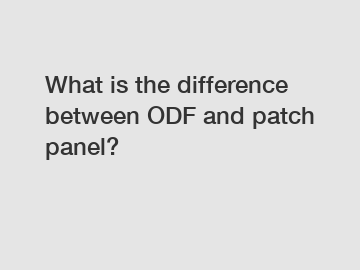Dec. 15, 2023
Electrical Equipment
KOLORAPUS Product Page
What is the Difference between ODF and Patch Panel?
In today's fast-paced technological world, the need for efficient and organized network systems is paramount. Two key components of network infrastructure include Optical Distribution Frames (ODFs) and Patch Panels. While both serve the purpose of managing and distributing network connections, they differ in terms of their design, functionality, and usage. In this article, we will explore the differences between ODFs and Patch Panels to help you understand which option is best suited for your networking needs.

Optical Distribution Frame (ODF).
H2: Overview of ODF.
An Optical Distribution Frame (ODF) is a rack-mounted device widely used for organizing and interconnecting fiber optic cables within a network infrastructure. It acts as a distribution point where incoming optical fibers from an optical line terminal (OLT) or other equipment are connected to individual fibers, allowing for efficient management and distribution of network connections.
H2: Design and Functionality.
ODFs are designed to accommodate and organize a large number of fiber optic cables. They typically consist of vertical or horizontal racks with multiple adapter panels or modules. These panels or modules contain pre-installed couplers or connectors, allowing for the termination and splicing of the fibers. ODFs also include cable management features such as cable routing, strain relief, and labeling, which help in organizing and maintaining the cables.
H2: Usage.
ODFs are commonly used in central offices, data centers, and telecommunication rooms where a significant number of fiber optic cables need to be managed and distributed. They provide a centralized point for technicians to access, modify, and troubleshoot the network connections. ODFs are particularly useful in situations where scalability and flexibility are required, as they allow for easy additions and modifications to the network.
Patch Panel.
Suggested reading:H2: Overview of Patch Panel.
A Patch Panel, on the other hand, is a device used to consolidate and terminate multiple network connections into a central location. It serves as a physical interface between the active equipment, such as switches or routers, and the network cables, allowing for quick and easy connectivity changes.
H2: Design and Functionality.
Patch Panels are designed to accommodate a variety of network cables, including Ethernet, coaxial, or fiber optic cables. They typically consist of a metal frame with multiple ports or jacks. These ports are where the network cables are plugged in, and each port is connected to a corresponding port on the active equipment. Patch Panels also have labeling or marking systems that make it easier to identify and manage the connections.
H2: Usage.
Patch Panels are commonly used in local area networks (LANs), data centers, and telecommunication rooms. They provide a convenient way to manage and organize network connections, as well as troubleshoot connectivity issues. Patch Panels simplify the process of connecting and disconnecting devices, as changes can be made by simply patching or unplugging the appropriate cables.
Closing paragraph:
In conclusion, while both ODFs and Patch Panels play crucial roles in managing network connections, they differ in terms of their design, functionality, and usage. ODFs are primarily used for managing and distributing fiber optic cables in situations where scalability and flexibility are required. On the other hand, Patch Panels are used to consolidate and terminate various network cables, making them ideal for LANs and data centers. If you require assistance in choosing the right solution for your networking needs, please do not hesitate to contact us.
[word count: 552].
If you want to learn more, please visit our website Outdoor Speaker cable Supplier.
Suggested reading:Previous: What is a carriage bolt used for?
Next: Upgrade Security with Face Recognition Guard Tour: For Sale!
Related Articles
If you are interested in sending in a Guest Blogger Submission,welcome to write for us!
All Comments ( 0 )